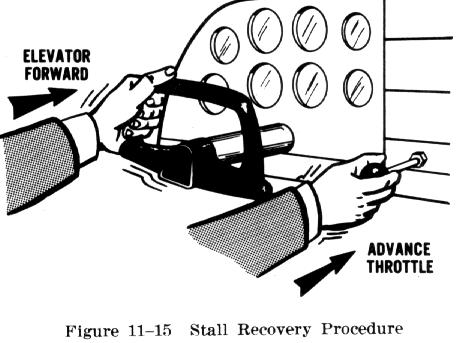
During the practice of intentional stalls the real objective
is not to learn how to stall an airplane but to learn how to recognize
an incipient stall and take prompt corrective action (Fig. 11-15). Though
the recovery actions must be taken in a coordinate manner, they are broken
down into three steps here for explanation purposes.
 |
First, at the indication of a stall, the pitch attitude and angle of attack must be decreased positively and immediately. Since the basic cause of a stall is always an excessive angle of attack, the cause must first be eliminated by releasing the back elevator pressure that was necessary to attain that angle of attack or by moving the elevator control forward. This lowers the nose and returns the wing to an effective angle of attack. The amount of elevator control pressure or movement used depends on the design of the airplane, the severity of the stall, and the proximity of the ground. In some airplanes a moderate movement of the elevator control - perhaps slightly forward of neutral - is enough, while in others a forcible push to the full forward position may be required. However, an excessive negative load thrown on the wings by excessive forward movement of the elevator may impede, rather than hasten, the stall recovery. The object is to reduce the angle of attack but only enough to allow the wing to regain lift. |
Second, the maximum allowable power should be applied to increase the airplane's speed and assist in reducing the wing's angle of attack. Generally, the throttle should be promptly but smoothly advanced to the maximum allowable position.
Although stall recoveries should be practiced without as well as with the use of power, in most actual stalls the application of more power, if available, is an integral part of the stall recovery. Usually, the greater the power applied, the less the loss of altitude.
Maximum allowable power applied at the instant of a stall
will usually not cause overspeeding of an engine equipped with a fixed
pitch propeller, due to the heavy air load imposed on the propeller at
slow airspeeds. It will be necessary, however, to reduce the power as airspeed
is gained after the stall recovery so the airspeed will not become excessive.
During practice stalls the tachometer indication should never be allowed
to exceed the red line (maximum allowable RPM) marked on the instrument.
Third, straight and level flight should be regained with
coordinated use of all controls.
Practice in both power on and power off stalls is important because it simulates stall conditions that could occur during normal flight maneuvers. For example, the power on stalls are practiced to show what could happen if the airplane were climbing at an excessively nose high attitude immediately after takeoff or during a climbing turn. The power off turning stalls are practiced to show what could happen if the controls are improperly used during a turn from the base leg to the final approach. The power off straight ahead stall simulates the attitude and flight characteristics of a particular airplane during the final approach and landing.
Usually the first few practices should include only approaches to stalls, with recovery initiated as soon as the first buffeting or partial loss of control is noted. In this way the pilot can become familiar with the indications of an imminent stall without actually stalling the airplane. Recovery should be practiced first without the addition of power, and then with the addition of power to determine how effective power will be in executing a safe recovery.
Stall accidents usually result from an inadvertent stall at a low altitude in which a recovery was not accomplished prior to contact with the surface. As a preventive measure, stalls should be practiced at a safe altitude using a recovery technique that will result in a minimum loss of altitude. To recover with a minimum loss of altitude requires an application of power, reduction in the angle of attack (lowering the airplane's pitch attitude), and termination of the sink without entering another stall.